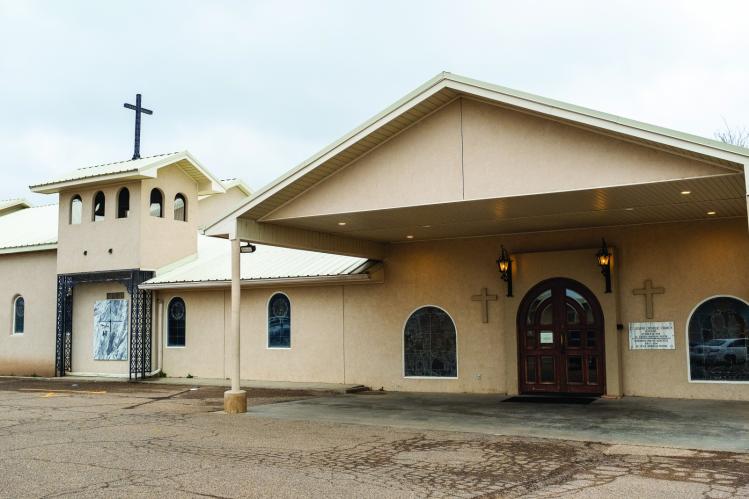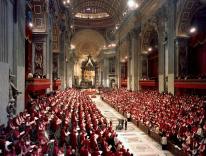
Editors’ Note: We’ve asked a number of authors to discuss the state of the American parish and what it means to be church in a time of migration and movement. We also wanted to offer practical suggestions for how parishes can be more welcoming, just, and Spirit-filled in these times. Together, our contributors provide a picture of the U.S. church today, one not so much in decline as undergoing a profound transition. To read all the articles, see the entire collection, The American Parish Today.
About two years ago I attended the closing Mass for the Master of Divinity program at Boston College, held in St. Ignatius, the campus church. It’s traditional for the community to invite graduating students up to the altar after the liturgy ends. As each graduate ascends to the altar, she is given a lit candle to hold as a symbol of the light she will bring to the world through her ministry. It’s intended to be a beautiful, proud, and sacred moment, but for me it felt very different.
I have a neurological condition called Charcot-Marie-Tooth (CMT) disease. Among other effects, CMT significantly impairs my balance and my ability to confidently ascend a set of stairs without a railing.
At my graduation Mass, I was confronted with exactly that: a railing-less altar. Instead of being able to take in the beauty of the moment, or consider with gratitude all the opportunities my education had gifted me, I was consumed with anxiety at the thought of climbing up and down those three altar stairs.
It wasn’t the first time I’d experienced this. I’ve been a fairly regular Mass-goer my entire life, but I am not a trained Eucharistic minister, nor have I ever been an altar server or a lector. The reason for this is painfully straightforward: the vast majority of Catholic altars are not accessible to me. Where there are accommodations, they often have their own problems. Take St. Ignatius. Technically, it does have a ramp. To use it at my graduation Mass, however, I would have had to exit the sanctuary, navigate a hidden hallway, and emerge from the side of the altar. That would have required me to interrupt my experience of the liturgy and temporarily exit the company of the community and the sacred space in which it was gathered, missing part of the ceremony and visibly lagging behind my fellow graduates.
But as many disabled churchgoers can attest, navigating altars is not the only problem. Often the challenges begin before even entering the church, at the front steps. If they are successfully managed, a number of other challenges await inside. These include finding accessible seats in the congregation (not just behind it), and locating an accessible bathroom, which usually requires a functioning elevator. It is not uncommon to come across elevators that have “Broken, Do Not Use” signs hanging with an accumulation of months or even years of dust.
[A quarter of U.S. parishes are operating at a financial deficit. See the data here.]
There’s no denying that creating fully accessible church facilities is often a massive undertaking. Doing so takes significant amounts of money, and updating older buildings can be particularly expensive. There are aesthetic concerns, too, as some find a ramp that juts into the sacred space, or a railing in the middle of the altar steps, distracting. But accessibility issues are also a matter of Catholic identity, and one of the most fundamental elements of that identity is our sacramental worldview—the belief that the material world can mediate God’s grace to us. Catholic churches are often beautiful reflections of this sacramental worldview, overflowing with visible symbols of God’s presence. The ornate sacred art, gleaming glass windows, and floral adornments are all meant to communicate the past and present story of God on earth.
Taking ourselves seriously as a sacramental people means that we cannot overlook the fact that a lack of accessibility mars this sacramental claim; inaccessible structures communicate unjust and damaging messages that not all are welcome. To take a previous example, inaccessible altar stairs imply that only certain kinds of bodies are worthy of accessing that sacred space. The church is often referred to as the Body of Christ, and the Body of Christ is meant to be the sacrament of God to the world. But what kind of sacrament are we if we limit the types of bodies that can access our sacred spaces and our liturgies?
Accessibility issues confront parishes with difficult questions, not all of which can be answered in the immediate future. Overhauling buildings requires long-term budgeting and strategic architectural planning—a difficult task for parishes that are already squeezed for funds. But there are smaller-scale, concrete steps with which parishes can begin. For example, parishes may consider reaching out to disabled members of their community about how accessible they find the parish. Leaders should intentionally seek out information about the lived realities of individuals who use wheelchairs or other assistive devices. Social-justice committees or parish councils might organize fundraisers to install ramps or railings at the entrance of the church and at the front of the altar, or to finally fix that broken elevator. Communities might also organize educational events or invite speakers with disabilities to share their experiences with the parish. When possible, parishes should invite marginalized members of the community into the heart of their sacred spaces and liturgical celebrations.
The effort to make sacred spaces accessible is not a peripheral issue; it is an issue at the core of our Catholic identity. What’s presented to us in our sacred spaces and especially at the altar—the Word of God, the sacraments, and the people mediating those to everyone gathered in worship—inform the entirety of our lives as People of God. Our work as Catholics is energized by what happens in these spaces and flows out of them as we strive to bring about the Reign of God. Parish communities should look at the altar next time Mass is held. Please notice: What kinds of bodies are on that altar? And perhaps more importantly, what kinds aren’t?
——
RELATED:

